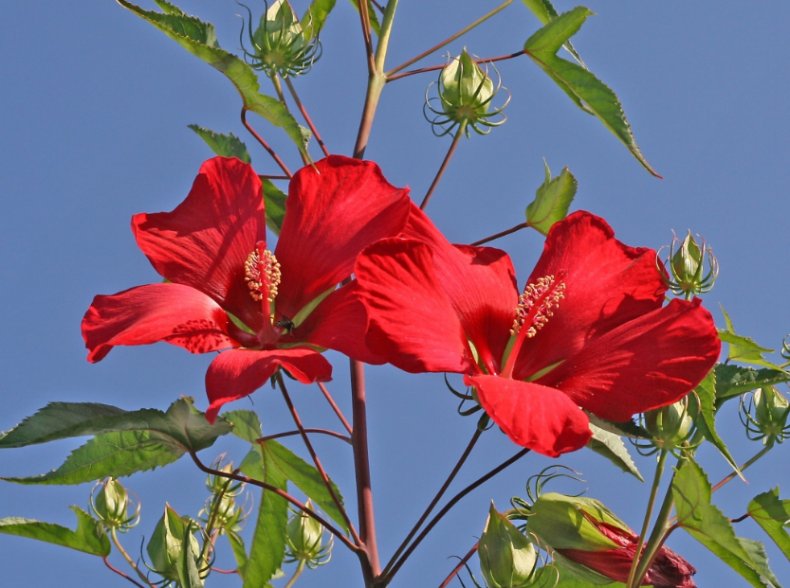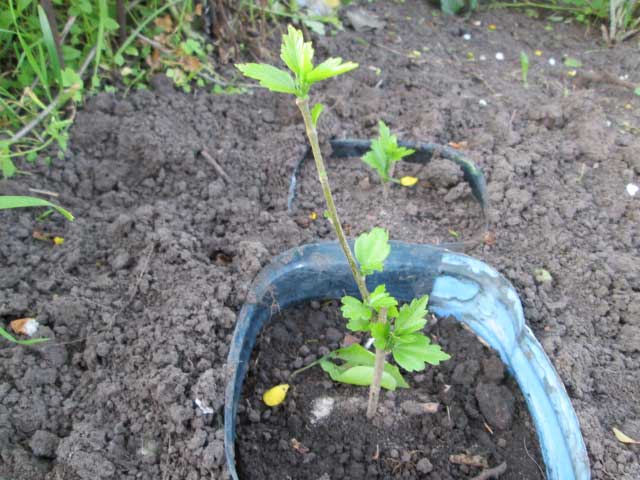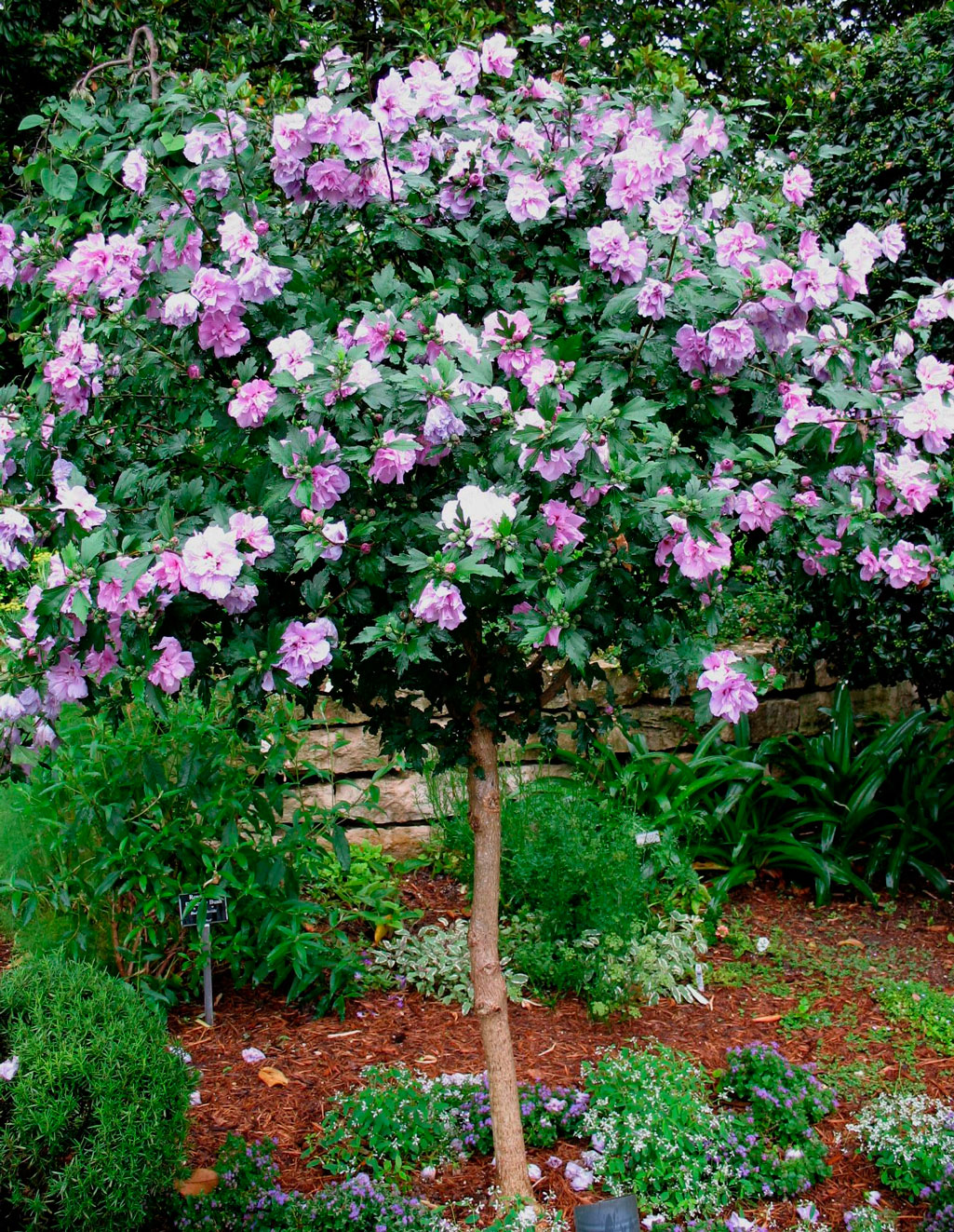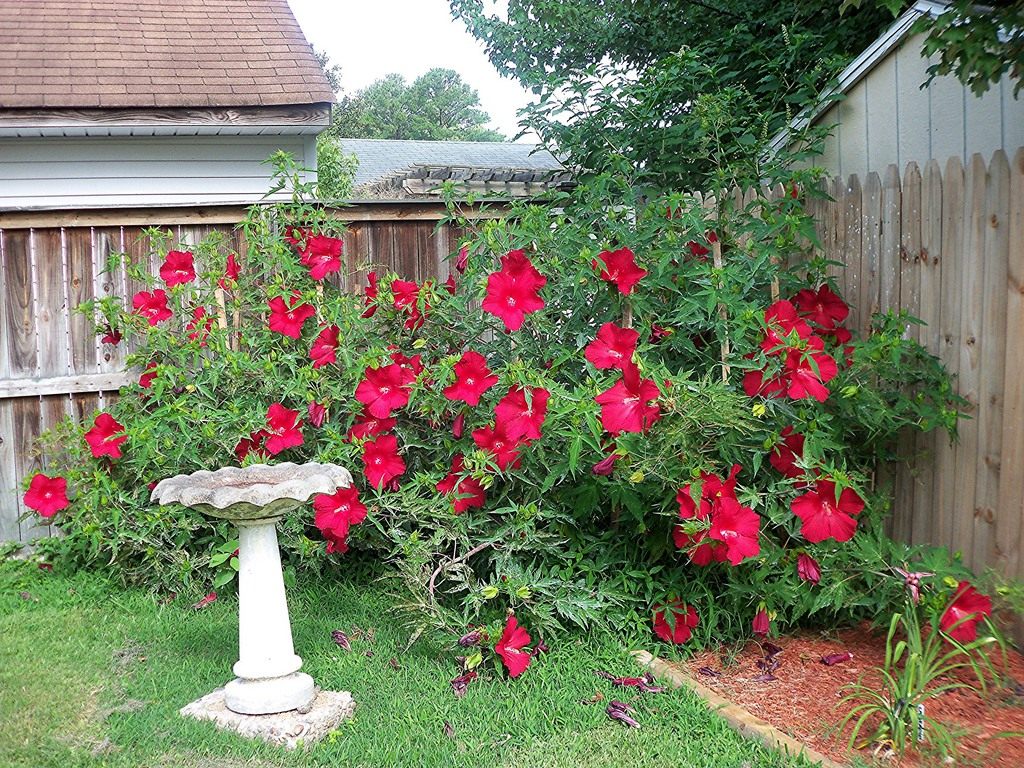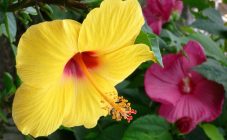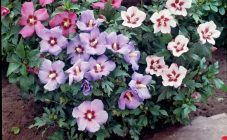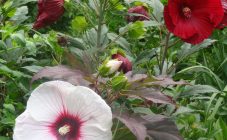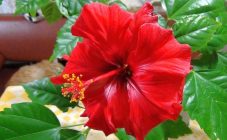Content:
Hibiscus has bright and large flowers that attract attention at first sight. It has long been bred at home, now garden hibiscus is popular. People who believe in omens unreasonably began to call hibiscus "the flower of death", why, by the way, no one will explain. Rather, due to the general anxiety of society.
What are hibiscus
When asked what hibiscus means, there is an explanation in the dictionary that this Latin word is borrowed from the ancient Greek language for the name of althea. In culture, there are 3 types of different varieties of hibiscus:
- herbaceous, or hybrid;
- garden, or Syrian;
- home, or tropical.
The first two are grown in the garden as flowering shrubs. The petals of funnel-shaped flowers are white, light pink, with a more saturated shade in the middle, red-crimson, purple, yellow, lilac. Both street species overwinter in the south of the country without shelter, withstand up to -29 ° C, rise to 120-180 cm in summer. They require minimal maintenance.
The indoor species is more often called the Chinese rose and is grown only at home. All species have a similar structure of spectacular flowers that live only one day, bushes and leaves differ.
Description of species
Breeders have adapted the current garden hibiscus to temperate climates since the 50s of the twentieth century. The herbaceous hybrid hibiscus has large one-day flowers, up to 20-25 cm in diameter.
Formed at the tops of the shoots. The stems are light green, strong, the bush spreads up to 60-90 cm. From a distance it can look like a stock-rose with huge petals. Blooms profusely from July to autumn. The plant is light-requiring. Before frost, shoots are cut off the ground, the base is mulched.
The garden species, which is called Syrian, as it was created on its basis, blooms, creating buds around the entire perimeter of the bush, which reaches up to 1.3-1.8 m in width. Single flowers, simple and double, with a diameter of 9-12 cm, are formed densely, different varieties have their own shades. There are vibrant two-tone petal combinations. With proper pruning, the flowers are large and plentiful every year. Without this procedure, they become noticeably smaller. The shrub is moisture - and photophilous.
A type of hibiscus with a different name - the Chinese rose, is grown indoors. The home flower is also unpretentious, growing up to 0.8-2 m. The main requirements in its agricultural technology are a bright place, warmth and high air humidity. The buds open simple and double, bloom from April to October.
In Russia, varieties with scarlet petals are more common, although collectors have plants with various colors. It is about this species that unjustified and unsubstantiated doubts arise: hibiscus, is it possible to keep such a flower at home? Lovers grow it and do not get rid of living decoration and natural air purifier, do not remove it from apartments.
Planting and reproduction of a plant
For garden hibiscus, seed propagation is possible, although varietal characteristics are unlikely to remain. Having collected the grains in the fall, in the spring they are germinated for a week in a moistened cloth, then placed in a substrate. Sprouts germinate in 17-22 days.
They are guaranteed to preserve the properties of the variety, propagating hibiscus by cuttings, which are cut in the warm season with a length of 10-12 cm.3-4 leaves are left at the top, cutting off half of each leaf blade. The lower part of the cutting is planted in a loose substrate, arranging a greenhouse. Sections take root after 20-30 days. When planting cuttings, root formation stimulants are used according to the instructions.
Chinese roses propagate just as easily in summer by cuttings, as Russians are traditionally ready to call the species of tropical hibiscus. Rooted plants are transplanted into pots after 45-50 days. For the first 4 years, tropical hibiscus are transferred into large pots every spring, while cutting off the branches by two-thirds after 2 years of growth. In the spring and summer, they are fed with fertilizers for decorative flowering plants, following the instructions.
Planting instructions
Large bushes are separated in early spring, replanted in new areas. When planting, a place with partial shade is selected, where the sun shines for at least 6 hours a day. The best soil acidity for hibiscus is 5.5-6.5. Humus or compost, sand are added to the substrate to the garden soil. Most often buy seedlings in containers.
Landing Algorithm:
- after digging a hole measuring 50 x 50 cm, arrange drainage with a layer of 10-15 cm;
- fill with a planting substrate and make a depression in it for a clod of earth for a seedling from a pot;
- the seedling is overloaded so that the top of the rhizome only deepens slightly into the ground;
- the soil is compacted around the trunk and a circular furrow is made for irrigation.
Care
Water the plant in moderation, make sure that the soil does not dry out. Mulching the trunk circle with crushed bark or perlite will help. Constantly keep the soil slightly damp during dry periods, otherwise the buds will not stick. Sprinkling in the evening will be beneficial.
They are fed from early spring, applying complex fertilizers for flowers, in which the nitrogen content is at least 16%. In summer, flowers need potassium. In August, September, fertilize with potassium-phosphorus preparations. In October, 30-40 liters of water are poured, mulched with humus, spud. In the regions of central Russia, later, young bushes are covered with spruce branches or burlap and spunbond.
After spring feeding, the hibiscus is cut off. It is necessary to remove the branches that grow inside the bush, and the damaged ones. Young shoots will grow quickly. Then the plant is formed by cutting the branches by 1/3. The bush will become more lush and by summer it will create large flowers that are formed on the shoots of the current year.
Room view care includes:
- regular watering and spraying of the plant;
- organization of a dormant period in winter with temperatures up to 14-16 ° C;
- highlighting a place with bright diffused light.
Disease and pest control
Both garden and indoor hibiscus are hardy, rarely get sick. When grown, they encounter yellowing and leaf fall. Chlorosis occurs due to a lack of iron and nitrogen. Feeding the plant with iron chelate will help to get rid of the ailment of the plant. After transplantation, the roots are supported with Zircon or Kornevin preparations.
Fin the arched summer without watering, the bush suffers from pests:
- The spider mite spoils the leaves by sucking out the juice. The symptom is yellow spots. For treatment, the bush is treated with acaricides.
- Thrips lay eggs in the buds, which fall off. Apply "Confidor", "Fitoverm", "Vertimek".
- The same drugs are used to get rid of aphids, whiteflies, mealybugs.
- Prevention is carried out in early spring, spraying the bush with a mixture of insecticide and fungicide, for example, "Aktara" and "Horus".
Landscape
Hibiscus adorns any semi-shaded corner of the yard. He is planted:
- in bouquet groups - near roses or other flowering shrubs;
- against the background of a strict coniferous wall;
- as a picturesque hedge when dividing the garden into zones;
- as a bright soloist in a flower bed, especially if formed by a stem.
Why hibiscus is called the flower of death
A persistent prejudice is tenaciously held in the popular environment. Why was garden hibiscus called the flower of death, and where did this strange omen come from? It is believed that it came from Europe and belongs to a beautiful indoor plant. There are myths that a flower that has not blossomed at the usual time of flowering is unfortunately. Because of this, someone doubts whether it is possible to keep hibiscus in an apartment; some superstitious people decide to remove the plant from the house.
Those housewives who do not believe in prejudices have admired the lush hibiscus for years, which illuminates the family life with its flowering. It is worth starting a spectacular bush in the garden. Simple cares will bring comfort and enhance the beauty of the garden.
